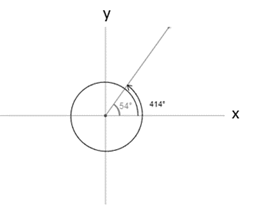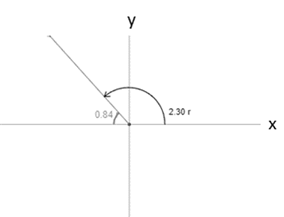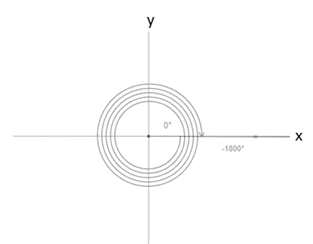
(a)
To calculate: The reference angle of
(a)
Answer to Problem 10E
The reference angle of
Explanation of Solution
Given information:
The angle
Formula used:
The reference angle
Calculation:
Consider the provided angle
Denote
Convert into degrees,
Recall that the reference angle
From the figure provided below,

The provided angle has terminal side in Quadrant
The reference angle is,
Thus, the reference angle of
(b)
To calculate: The reference angle of
(b)
Answer to Problem 10E
The reference angle of
Explanation of Solution
Given information:
The angle
Formula used:
The reference angle
Calculation:
Consider the provided angle
Denote
First convert
Recall that the reference angle
From the figure provided below,

The provided angle has terminal side in Quadrant
The reference angle is,
Thus, the reference angle of
(c)
To calculate: The reference angle of
(c)
Answer to Problem 10E
The reference angle of
Explanation of Solution
Given information:
The angle
Formula used:
The reference angle
Calculation:
Consider the provided angle
Denote
First convert
Recall that the reference angle
From the figure provided below,

The provided angle has terminal side on positive
The reference angle is,
Thus, the reference angle of
Chapter 6 Solutions
Precalculus: Mathematics for Calculus - 6th Edition
- please do #48arrow_forward43–46. Directions of change Consider the following functions f and points P. Sketch the xy-plane showing P and the level curve through P. Indicate (as in Figure 15.52) the directions of maximum increase, maximum decrease, and no change for f. ■ 45. f(x, y) = x² + xy + y² + 7; P(−3, 3)arrow_forwardplese do #48arrow_forward
- 43-46. Directions of change Consider the following functions f and points P. Sketch the xy-plane showing P and the level curve through P. Indicate (as in Figure 15.52) the directions of maximum increase, maximum decrease, and no change for f. T 45. f(x, y) = x² + xy + y² + 7; P(−3, 3)arrow_forwardSolve the differential equation by variation of parameters 3x2y" + 7xy' + y = x2 - xarrow_forward2 x² + 9 d x 1 x +9 dxarrow_forward
- DO these math problems without ai, show the solutions as well. and how you solved it. and could you do it with in the time spandarrow_forwardThe Cartesian coordinates of a point are given. (a) (-8, 8) (i) Find polar coordinates (r, 0) of the point, where r > 0 and 0 ≤ 0 0 and 0 ≤ 0 < 2π. (1, 0) = (r. = ([ (ii) Find polar coordinates (r, 8) of the point, where r < 0 and 0 ≤ 0 < 2π. (5, 6) = =([arrow_forwardThe Cartesian coordinates of a point are given. (a) (4,-4) (i) Find polar coordinates (r, e) of the point, where r > 0 and 0 0 and 0 < 0 < 2π. (r, 6) = X 7 (ii) Find polar coordinates (r, 8) of the point, where r < 0 and 0 0 < 2π. (r, 0) = Xarrow_forward
 Calculus: Early TranscendentalsCalculusISBN:9781285741550Author:James StewartPublisher:Cengage Learning
Calculus: Early TranscendentalsCalculusISBN:9781285741550Author:James StewartPublisher:Cengage Learning Thomas' Calculus (14th Edition)CalculusISBN:9780134438986Author:Joel R. Hass, Christopher E. Heil, Maurice D. WeirPublisher:PEARSON
Thomas' Calculus (14th Edition)CalculusISBN:9780134438986Author:Joel R. Hass, Christopher E. Heil, Maurice D. WeirPublisher:PEARSON Calculus: Early Transcendentals (3rd Edition)CalculusISBN:9780134763644Author:William L. Briggs, Lyle Cochran, Bernard Gillett, Eric SchulzPublisher:PEARSON
Calculus: Early Transcendentals (3rd Edition)CalculusISBN:9780134763644Author:William L. Briggs, Lyle Cochran, Bernard Gillett, Eric SchulzPublisher:PEARSON Calculus: Early TranscendentalsCalculusISBN:9781319050740Author:Jon Rogawski, Colin Adams, Robert FranzosaPublisher:W. H. Freeman
Calculus: Early TranscendentalsCalculusISBN:9781319050740Author:Jon Rogawski, Colin Adams, Robert FranzosaPublisher:W. H. Freeman
 Calculus: Early Transcendental FunctionsCalculusISBN:9781337552516Author:Ron Larson, Bruce H. EdwardsPublisher:Cengage Learning
Calculus: Early Transcendental FunctionsCalculusISBN:9781337552516Author:Ron Larson, Bruce H. EdwardsPublisher:Cengage Learning





